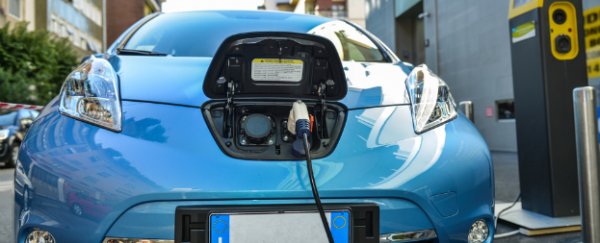Electric cars are often touted as the future of sustainable transport, but they're held back by the fact that they require really heavy, slow-releasing batteries to power them - even the top-end Lithium-ion batteries on the market charge extremely slowly and weigh a lot.
A far better option would be to use supercapacitors - devices that can release energy in large bursts - but they're unable to store as much energy as batteries, and so it would take a lot of them in order to power something as big as a car.
Scientists have instead been working on ways to combine batteries and supercapacitors in order to make batteries more powerful and lighter in the short-term. But the ultimate goal is to develop a supercapacitor that could also store large amounts of energy.
Now nanotechnologists from Queensland University of Technology (QUT) in Australia have developed an ultra lightweight supercapacitor that can easily be combined with regular batteries to dramatically boost their power while decreasing their weight - and within five years could eliminate the need for batteries altogether.
"Supercapacitors offer a high power output in a short time, meaning a faster acceleration rate of the car and a charging time of just a few minutes, compared to several hours for a standard electric car battery," said Marco Notarianni, a PhD researcher from QUT who worked on the project, in a press release.
But the potential of these devices goes beyond simply upgrading our current batteries - they could also replace them.
The team's supercapacitors are a "sandwich" of electrolyte wedged between two strong sheets of extremely strong but light graphene. The researchers are now working on getting them to store more energy, but they're so thin and and lightweight that they could eventually be embedded into a car's body panels, roofs, door, bonnet and floor, and used to power the car for around 500 km.
Even more impressively, a battery-free car made up of these parts would only need to be charged for a couple of minutes.
The team's research has been published in theJournal of Power Sources and Nanotechnology, and Notarianni says that a car powered by its own body parts could be a reality within five years.
"After one full charge this car should be able to run up to 500km - similar to a petrol-powered car and more than double the current limit of an electric car," said Jinzhang Liu, a materials engineer who also worked on the supercapacitor, in the release.
The technology could also have other exciting potential - such as being put on the back of your smart phone to help it charge extremely quickly.
Importantly, supercapacitors aren't only good for speeding up power storage, they're also more environmentally friendly than Lithium-ion batteries and will be cheaper too.
"The price of Li-Ion batteries cannot decrease a lot because the price of Lithium remains high. This technique does not rely on metals and other toxic materials either, so it is environmentally friendly if it needs to be disposed of," said nanotechnologist Nunzio Motta who led the team.
Want to create game-changing technology? QUT has some of the most advanced nanotechnology labs in Australia - find out more about studying with their world-leading researchers.
